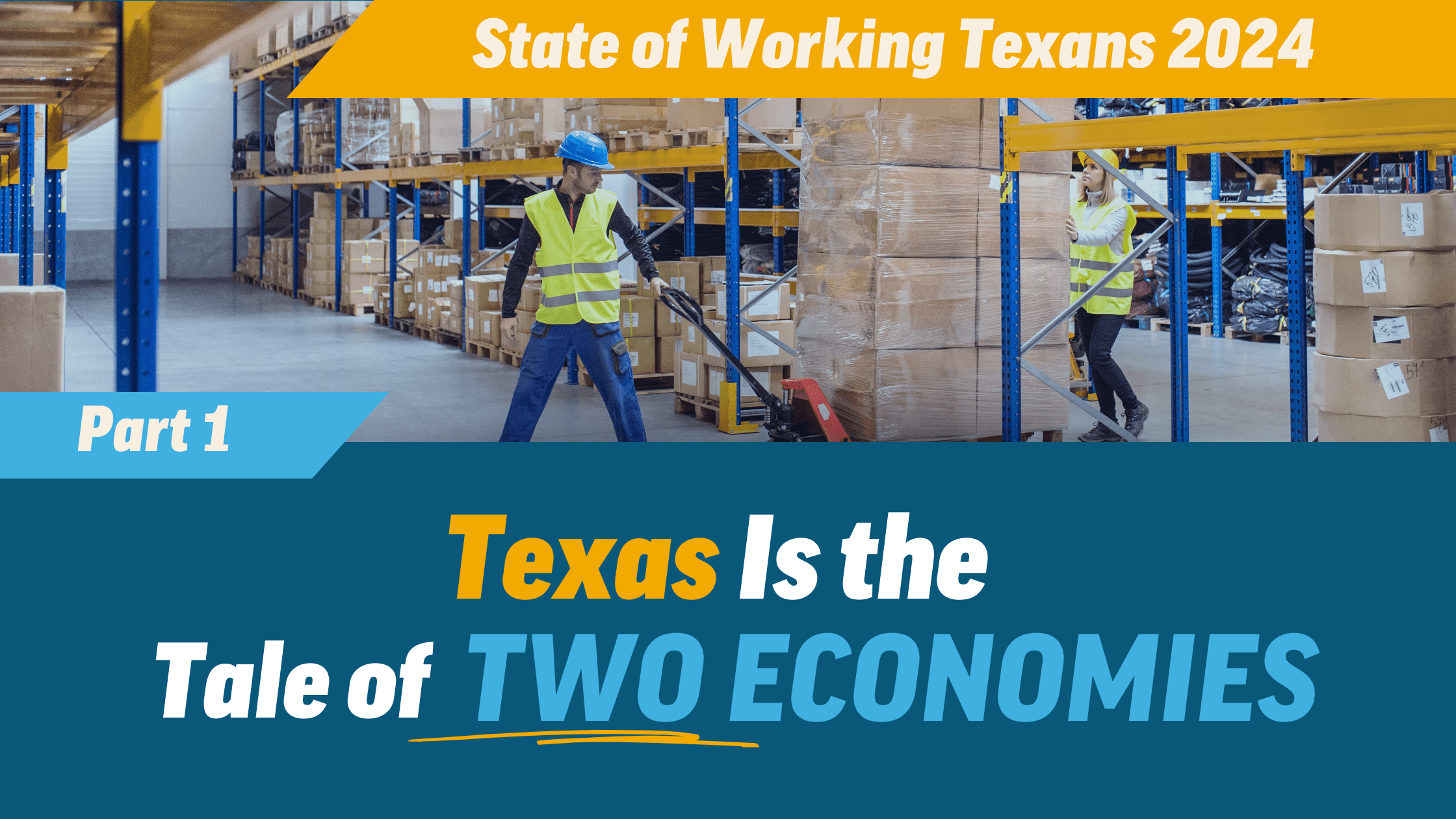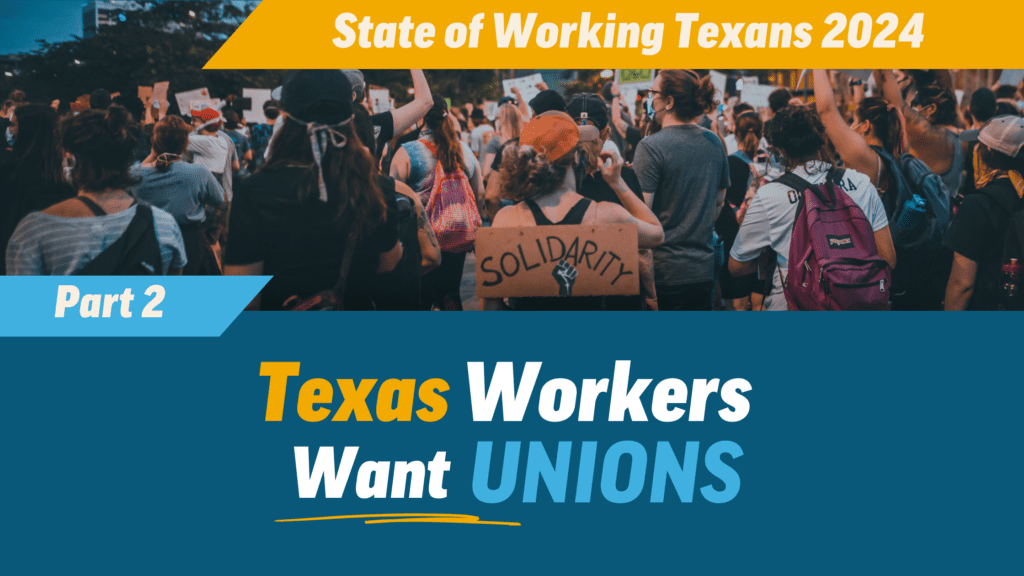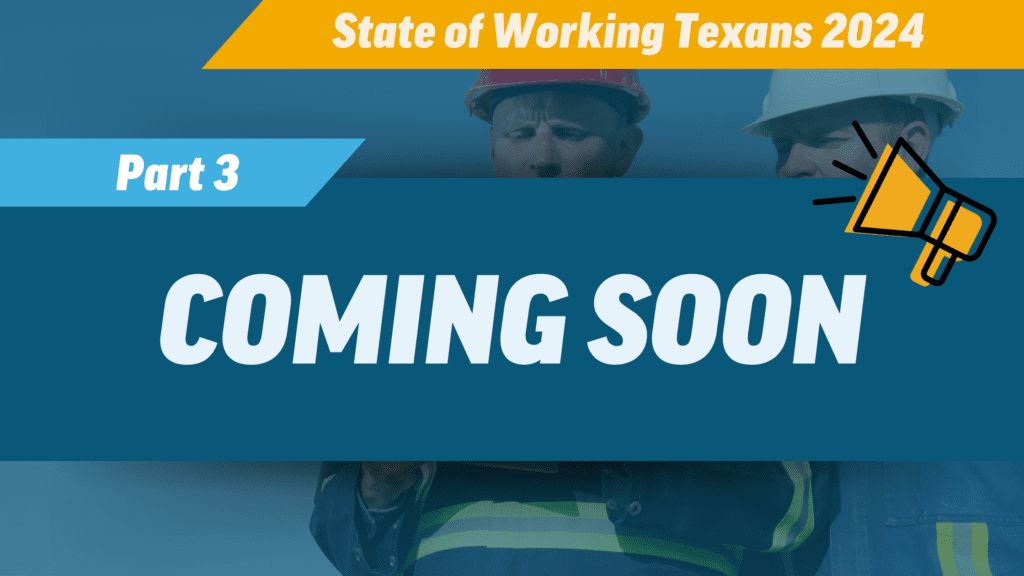Texas Is the Tale of Two Economies
Working Texas Families Are Worth Our Fair Share of Economic Abundance
While our state’s economy thrives across various production metrics, the benefits are not equitably distributed among us. Texans of all backgrounds, regardless of race, income, and gender, are worth a fair shot at prosperity and a fair share of our state’s economic abundance.
Working Texans produce a booming and robust state economy by many measures. Texas boasts the second-largest state economy in the country, representing nearly 10% of the U.S. economy. In nearly 30 years, our state economy has more than doubled, ranking fourth nationally in terms of growth. With Texas leading in job creation in 2023, and as one of the fastest-growing state populations, our economy demonstrates strong potential for continued expansion.
This prosperity is fueled by hardworking Texans, whether they live in rural Victoria or densely populated Dallas. However, working people are not getting the abundance we create. Texas’ widening economic gap has resulted in one of the nation’s highest poverty rates, where 2 in 5 Texans struggle to meet their basic needs. This disparity is particularly acute among Black, Latino, and rural communities.
Our state’s economic abundance should be meaningfully invested back into our communities to make life more manageable. Working people and Texas families are pulling together to fund our communities, yet some Texas lawmakers side with the wealthy few against us. Our elected officials fail to translate our flourishing economy into long-term, people-centered investments. Rather than adequately funding our people’s priorities, Texas ranks 45th in general state expenditures per capita, compared to other leading state economies like California, New York, and Illinois.
Texas’ Economy Leads Among Top Performing States
Since 2006, our state’s economy has ranked as the second-largest in the nation as measured by Gross Domestic Product (GDP), the value of the final goods and services produced. While GDP is commonly used to gauge economic performance, it does not accurately represent the financial stability and prosperity of working families.
In 2022, Texas’ GDP reached $1.88 trillion (in chained 2012 dollars), falling second to California’s $2.89 trillion economy. Texas accounted for 9.4% of the entire U.S. GDP that same year. Texas also displayed strong per capita and per worker economic indicators in 2022. With a per capita GDP of $62,483, Texas ranked 15th and 8th respectively compared to other states.
As one of the fastest-growing states in the country, Texas experienced considerable economic growth from 1997 to 2022. In the last 25 years, Texas’ GDP saw a significant growth of 115% from $870 billion. The state ranked fourth in this measure behind Utah, North Dakota, and Idaho. Texas saw faster GDP growth than the nation and the largest state economies: California, New York, Florida, and Illinois. Over these years, Texas’ GDP per capita rose a significant 39%, to $62,483 from $44,986, landing our state in 16th place. Texas tied with the nation in GDP per capita growth, but surpassed Florida and Illinois. Texas’ productivity, measured in GDP per worker, increased by 38% to $139,415 from $100,744, landing Texas in 18th place.
Texas’ economy has been more resilient in recent decades. After the painful oil bust of the 1980s, our state economy evolved into a more diverse and service-oriented system, better able to weather recessions and other downturns. Even the one-two punch of COVID-19 and a drop in oil prices in early 2020 did not leave a lasting dent in Texas’ growth.
Many economists are aware of the shortcomings of GDP and have devised other measures to comprehensively gauge economic well-being. The United Nations calculates a Human Development Index (HDI) to compare countries’ health, education, and standards of living. At the national level, the U.S. Bureau of Economic Analysis has developed a number of prototype measures of the economy that – unlike GDP – include income and wealth distribution, well-being, and other social and environmental metrics. A few states, including Maryland, now provide official estimates of a similar statistic called the Genuine Progress Indicator (GPI). Texas is among a handful of high-GDP states with comparatively low GPI scores, which further suggests that a state’s GDP does not necessarily translate to the well-being of its people.
Working Texans Drive Economic Prosperity but Do Not Get Our Fair Share
Some of our elected officials are quick to take credit for Texas’ success, but what they call the “Texas miracle” is just the hard work and remarkable accomplishments of everyday Texans.
Powerful Texas politicians fail to promote fair distribution of our state’s economic abundance while simultaneously fueling divisions between families based on skin color, faith, and gender identity. Since our system is skewed in favor of the wealthy, many hardworking Texas families are denied their rightful share of the state’s prosperity. Despite our skyrocketing GDP, our state policies present obstacles to working Texans that exacerbate economic immobility, widen wealth gaps, and make it challenging to afford basic necessities.
The influence of the richest corporations and billionaires on our political landscape consolidates wealth among corporations and the select few, making it harder to afford a quality life. State-level policy is a critical component to building a robust and multiracial middle class.
Texas Policies Hinder Economic Mobility
Half of American adults earn less than their parents, and it is not for a lack of hard work. According to a study conducted by Raj Chetty, et al, 90% of American adults born in the 1940s earn more than their parents, compared to 50% of adults born in the 1980s. A prosperous GDP cannot alone return absolute mobility – the fraction of adults who earn more than their parents – to the standards experienced by adults born in the 1940s. The distribution of economic growth could potentially alleviate the decline in income mobility for as many as 70% of Americans. Our state needs policies that bolster income mobility and ensure future generations can thrive in tandem with the state’s promising economy.
Texas’ Upside-Down Tax System Creates Extreme Wealth and Tax Inequality
In Texas, 66 billionaires earn more than 70% of Texans combined. This extreme concentration of wealth is the result of public policies that prioritize tax giveaways and cuts for the wealthiest corporations and people. Texas’ upside-down tax policies mean that the lowest-income Texans pay the highest share in taxes. This burden could be alleviated by a wealth tax on the richest Texans, which is now banned by the state constitution. Amidst the unequal tax burden, the state continues to give big handouts to corporations. In 2023, Texas renewed a damaging corporate tax giveaway program that could lead to at least $336 million in forgone public school revenue.
Texas Families Experience Widespread Financial Hardship
In 2021, Texas ranked 10th in the nation for poverty rates at 14.2%, surpassing the national average by 1.4%. While this ranking is concerning, the reality of hardship is more distressing. Nearly 43% of Texan households – about 4.6 million of 10.7 million – struggle to afford essential expenses like housing, child care, food, transportation, health care, technology, taxes, and unexpected costs. Fourteen percent of households (1,460,106) fell below the Federal Poverty Level (FPL) in 2021, while an additional 29% (3,099,184) were classified as ALICE (Asset Limited, Income Constrained, Employed) households by United For ALICE’s analysis. These are households with incomes higher than the FPL but still too low to afford basic necessities. According to these figures, at least 1 in 5 Texan households live below the ALICE threshold in every county.
Despite the sustained economic expansion marked by GDP growth, the percentage of ALICE households has remained above 40% since 2010, underscoring the fact that working Texans do not get a fair share of the state’s long-standing prosperity.
Households across various demographic groups face financial hardship, though certain households experience financial hardship at higher rates as a result of systemic racism, ageism, gender discrimination, and geographical barriers to opportunity.
- 57% of Black and 51% of Latino households in Texas experience financial hardship, compared to 34% of white households.
- Both the youngest (under age 25) and oldest (age 65+) individuals face the highest rates of financial hardship.
- Single-parent families with children are more likely to experience financial hardship compared to married-parent households or single/cohabiting households without children.
- 47% of rural households experience financial hardship compared to 42% of urban households.
State Leaders Fail to Turn Strong GDP Growth Into People-Centered Investments
We have the money to make meaningful investments in our communities.
According to 2021 U.S. Census Bureau data, Texas ranked 45th in general state expenditures per capita at $4,460 compared to the nation’s $5,362. With local spending taken into account, Texas ranked 36th – still below the national average. A different measure calculated by the Kaiser Family Foundation placed Texas last in state spending per resident. In terms of spending per worker, Texas’ $10,118 average landed the state in 42nd place, also below the national average of $12,086. Even with local spending included, Texas still runs lower than the national average, ending in 35th place.
Many of our elected officials keep state tax and spending at a minimum to appease their wealthy supporters — who want public goods to remain as meager as possible so their taxes do not have to pay for them. Since 2019, the Texas Legislature has capped local property tax revenue growth at 3.5% per year for cities and counties and at 2.5% for school districts. This robs local elected officials of their fiscal authority and leaves less money per person for education, health care, infrastructure, roads, and transit.
Working Families Deserve a Budget That Delivers Shared Prosperity
While Governor Abbott and other powerful elected officials boast one of the largest economies in the nation, this prosperity is not distributed equitably by design. Because our per-resident government spending is not at a level that meets the needs of all Texans, many working families – especially those from Black, Latino, low-income, and rural communities – struggle with financial hardship.
It is imperative to increase investment in our people to address these disparities, which are exacerbated by systemic racism, ageism, and gender discrimination. State leadership must enact a People’s Budget that prioritizes proactive policy measures and investments aimed at fostering economic growth and opportunity for all Texans. Our working families are worth it, and the future of our state depends on it.


